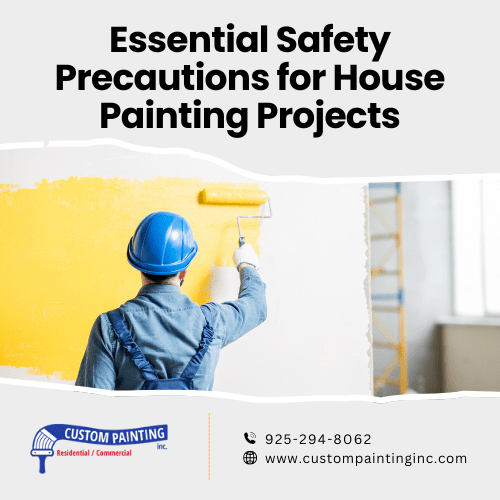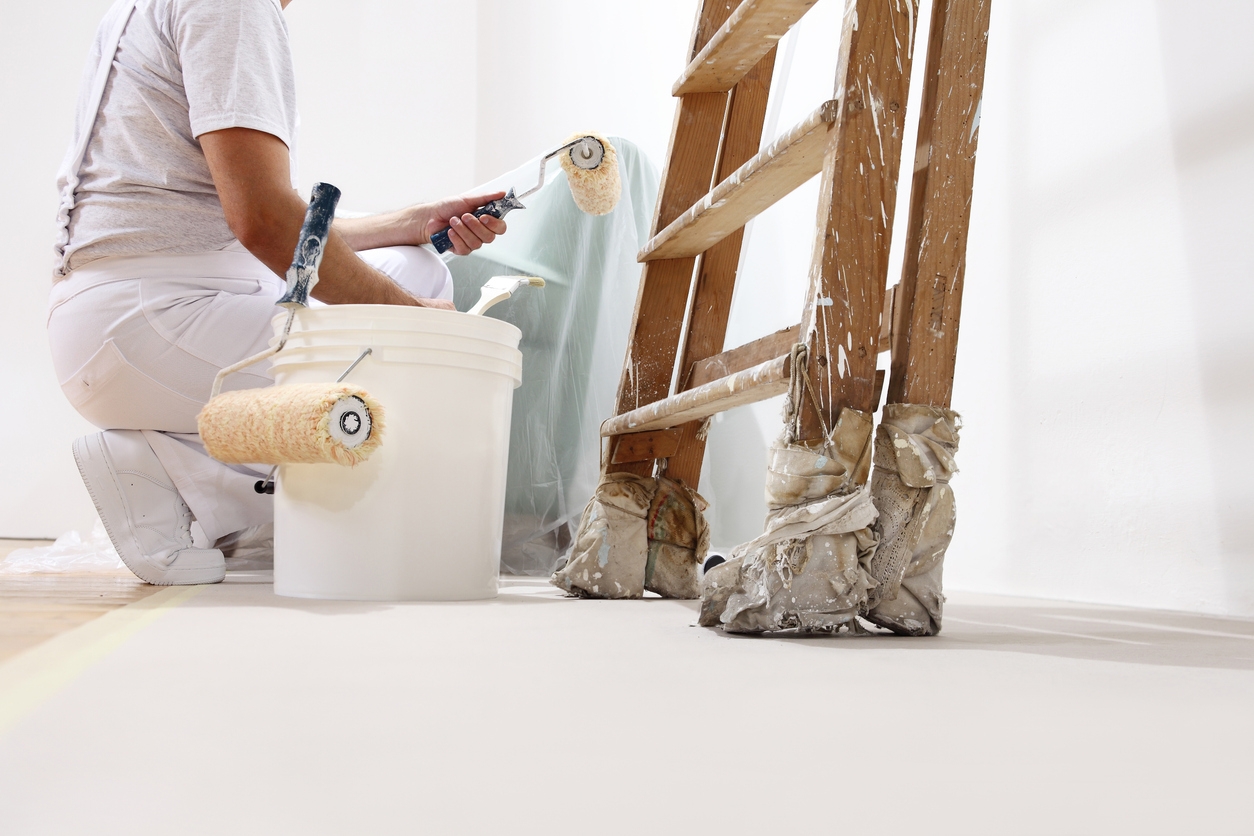In house painting and other home improvement projects, safety should be paramount. It is crucial to prevent accidents, injuries, and long-term health issues. Safety ensures the painters and occupants’ well-being, maintains a professional work environment, and avoids costly legal issues.
Here are some of the common risks associated with house painting projects:
- Falls – Working on ladders or scaffolding poses a risk of falling from heights.
- Exposure to fumes – Paints and solvents can release harmful fumes, leading to respiratory issues or poisoning.
- Chemical burns – Improper handling of chemicals can cause skin burns or eye injuries.
- Lead poisoning – Disturbing old paint layers can release toxic lead dust, especially in homes built before 1978.
- Electrical hazards – Painting near electrical outlets or wiring can lead to electric shocks or fires.
Preparing for the project
Planning and scheduling
- Planning the project timeline is important. Proper planning ensures the project stays on track, minimizes downtime, and helps allocate resources efficiently.
- Checking weather conditions for exterior painting. Weather conditions can significantly affect the quality and durability of exterior paint. Painting in optimal weather ensures better adhesion and longevity.
Gathering supplies and tools
- List of necessary painting supplies:
- Paint
- Brushes
- Rollers
- Painter’s tape
- Drop cloths
- Primer
- Paint trays
- Extension poles
- Ensuring tools are in good condition: Using well-maintained tools ensures a smooth application, reduces the risk of accidents, and improves the overall finish quality.
Reading and understanding labels
- Importance of reading paint and tool labels: Labels provide crucial information on usage, safety, and compatibility. It ensures the best results and safe application.
- Understanding hazard warnings and instructions: Awareness of hazards and following instructions prevent accidents and health risks. It makes the entire working environment a lot safer.
Personal protective equipment (PPE)
Protective clothing
- Wearing long sleeves, pants, and gloves: These garments provide a barrier against chemical splashes, cuts, and abrasions, reducing the risk of skin injuries.
- Selecting the right footwear: Proper footwear, such as steel-toed boots, protects feet from heavy falling objects, punctures, and other workplace hazards.
Respiratory protection
- Using masks or respirators: These devices prevent inhalation of harmful fumes, dust, and chemicals. These contaminants cause respiratory issues or long-term health problems.
- Importance of ventilation in enclosed spaces: Adequate ventilation reduces the concentration of hazardous substances in the air. The result is a safer breathing environment.
Eye and ear protection
- Wearing safety goggles: Goggles shield eyes from chemical splashes, flying debris, and other potential hazards, preventing eye injuries.
- Using ear protection: Earplugs or earmuffs protect hearing when working with loud machinery, reducing the risk of noise-induced hearing loss.
Ensuring a safe working environment
Clearing the area before painting
- Removing furniture and obstacles: Move all furniture and objects out of the painting area to ensure a clear workspace.
- Protecting floors and immovable items with drop cloths: Cover floors and other items that can’t be moved with drop cloths to protect them from paint splatters.
Proper ladder usage
- Selecting the right ladder for the job: Choose a ladder of appropriate height and type for the specific task to ensure safety.
- Ensuring ladder stability and proper placement: Set the ladder on a stable, level surface and follow safety guidelines for placement to prevent falls.
Electrical safety
- Turning off power when painting near electrical outlets: Switch off power to the area to avoid electrical hazards while painting near outlets and switches.
- Avoiding contact with electrical fixtures: Be cautious and avoid direct contact with any electrical fixtures to prevent accidents.
Safe handling and disposal of materials
Handling Paint and Solvents
Storing materials in a safe, ventilated area:
- Paints and solvents should be stored in a well-ventilated area to prevent the buildup of harmful fumes.
- Keep containers tightly closed when not in use to prevent spills and evaporation.
- Store materials away from heat sources and direct sunlight. It reduces the risk of fire and degradation of the chemicals.
- Use approved storage cabinets for flammable liquids to enhance safety.
Avoiding skin contact and inhalation:
- Wear appropriate personal protective equipment (PPE) such as gloves, goggles, and masks to prevent skin contact and inhalation of fumes.
- Use paints and solvents in well-ventilated areas, preferably with exhaust fans or open windows, to ensure adequate airflow.
- If working indoors, use a respirator designed to filter out harmful paint and solvent fumes.
Disposal of waste
Proper disposal methods for paint cans and solvents:
- Do not dispose of liquid paints or solvents in regular trash or pour them down drains. They can contaminate water supplies and harm the environment.
- Allow leftover paint to dry out in a well-ventilated area. Another option is to use a paint hardener before disposing of it in the trash.
- Solvents should be collected in a designated container and taken to a hazardous waste disposal facility.
Local regulations for hazardous waste disposal:
- Check with local environmental agencies or waste management authorities for specific guidelines on disposing of hazardous materials like paint and solvents.
- Many areas offer special collection days or facilities for hazardous waste disposal, ensuring safe and environmentally friendly handling.
- Follow all local regulations and guidelines to avoid fines and ensure the protection of public health and the environment.
Emergency preparedness
First aid kit
- Keeping a first aid kit on hand: Always have a well-stocked first aid kit accessible. Ensure it includes bandages, antiseptic wipes, gauze, adhesive tape, scissors, tweezers, and pain relievers.
- Basic first aid procedures for common injuries: For minor cuts, clean the wound with antiseptic and cover it with a bandage. For paint or chemical splashes in the eyes, rinse with plenty of clean water for at least 15 minutes. For minor burns, cool the area under running water and cover with a sterile, non-stick bandage.
Emergency contacts
- Having emergency contact numbers readily available: Keep a list of emergency contact numbers, including local poison control, emergency medical services, and family members, posted in a visible location.
- Knowing the location of the nearest emergency facility: Familiarize yourself with the nearest hospital or urgent care center. Know the fastest route to get there in case of a severe injury.
Conclusion:
When house painting, put safety first above all else. Follow safety guidelines diligently to prevent accidents and ensure a smooth painting process. Prioritizing safety in all painting projects protects you and those around you. It also guarantees a pleasant experience and a quality paint finish. Always put safety first!
After reading this, you might want to hire professionals like Custom Painting, Inc., and not worry about the risks. Depending on the project, hiring our paint experts can be the better option! Call us at 925-686-0903 or complete our contact form for a free site assessment and job estimate.


